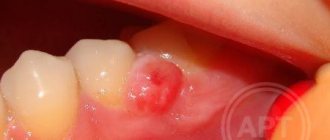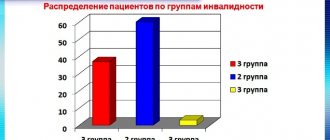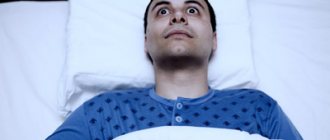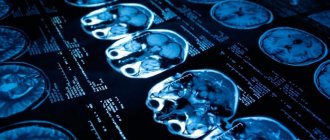Epilepsy in newborns and children under one year of age manifests itself somewhat differently than in adults.
Often parents do not notice alarming symptoms, perceiving them as features of infant behavior.
In addition, seizures are not always of an epileptic nature. Therefore, it is important to carefully examine the baby; the experienced eye of a doctor will always notice the characteristic signs of epilepsy in an infant.
Causes
According to medical statistics, epilepsy in infancy is much more common than in adults.
This is explained by the immaturity of brain structures, so the brain is sensitive to any irritants and reacts by increasing convulsive activity.
The positive point here is that in 70% of those affected during puberty, attacks disappear as the brain reaches its maturity.
The main causes of epilepsy in newborns:
- Hereditary factor. It has been proven that a child whose parents are sick has a higher risk of inheriting a tendency to pathology.
- Birth injury . The risk increases with prolonged labor, the use of vacuum extraction, and entanglement of the umbilical cord. If the mother has a narrow pelvis, the baby's head is compressed during birth and the brain may be damaged.
- Neuroinfections . Diseases such as meningitis, encephalitis, and influenza are very dangerous for a fragile child’s body. Seizures are often complications of these diseases.
- Head injuries. For a child, any bruise can become an impetus for the development of serious pathologies.
- Underdevelopment of the brain. Seizures occur especially often in premature babies.
- Genetic diseases in which chromosomal pathology is observed (Down disease).
- Idiopathic causes. A baby is born with a lack of dopamine, which is responsible for regulating the processes of excitation and inhibition.
Epilepsy in children
Considering the localization of the epileptic process, as well as the background against which the seizures occurred, the disease has a large number of forms depending on the location, age, symptoms, and manifestations of syndromes:
Frontal epilepsy
Occipital epilepsy
Temporal lobe epilepsy
Parietal epilepsy
Rolandic epilepsy is one of the forms of epilepsy that manifests itself at any age of the child, from 2 to 14 years, most often accompanied by short nocturnal facial seizures. The disease has a favorable prognosis.
The clinical symptoms of seizures include simple partial (motor, sensory, less often vegetative), complex partial (motor and secondary generalized) seizures. Often during sleep, patients may make peculiar sounds such as “gurgling,” “grunting,” or “gargling.” The manifestation of motor and sensory paroxysms (short-term disorders) is minimal, so parents may not pay attention to them.
Rolandic epilepsy begins with an attack with a somatosensory aura: a feeling of tingling, numbness, “electric tingling” in the throat, tongue, and gums. After this, the attack may end or develop into a partial motor attack. Seizures may occur while the child is sleeping. The duration of the attacks is short: from a few seconds to 2-3 minutes. A small number of severe, prolonged attacks ending in transient post-ictal paresis (Todd's palsy) have been recorded. The frequency of attacks is on average 2-4 times a year. When a child is 1-2 years old, seizures may occur more frequently, but over time they will occur less frequently. In young children, seizure frequency may be high, weekly or even daily, during the first year of diagnosis. Night attacks are considered typical, mainly when falling asleep and waking up. The course of this form of epilepsy is favorable and has a good prognosis with spontaneous remission in almost all cases.
Idiopathic partial epilepsy with occipital paroxysms (IEP) is a form of this childhood disease with simple partial seizures with visual disturbances - hallucinations, photogsia (flashes of light), visual illusions (macro-, micropsia, metamorphopsia), migraine-like symptoms - headache, diffuse or hemicrania type, nausea, vomiting, dizziness, as well as motor and convulsive disorders. Currently, there are 2 variants of IPE – with early and late onset. The disease begins in the age range of 2-12 years with two peaks of onset - at 3-5 (early form) and 9 (late form) years, manifests itself as simple (motor and sensory), complex (motor and psychomotor), partial and secondary generalized convulsive seizures. The classic variant of ISE is late-onset occipital epilepsy (Gastaut epilepsy).
Autonomic paroxysms include epigastric sensations, nausea, vomiting, headache, dizziness. The duration of attacks varies: from several minutes to several hours; the frequency is usually low. There is a type of ISE with an early onset of seizures - at the age of about 4 years (Panayotopoulos epilepsy). Characterized by severe attacks, starting with vomiting, headache, followed by tonic abduction of the eyes and head. Seizures usually end in unilateral or generalized tonic-clonic seizures. An extremely prolonged loss of consciousness is noted - from tens of minutes to several hours. Seizures occur during sleep, especially before patients awaken. The prognosis for IPE is favorable. Complete remission occurs in 95% of cases.
Primary epilepsy when reading is a form of epilepsy with a presumed localization of the focus in the temporoparietal region; the main clinical sign is provocation of epileptic seizures when reading. The age of patients varies from 12 to 29 years. Seizures occur after reading the first words of the text. In some cases, attacks can be provoked by playing chess, cards and other board games, mental arithmetic, or writing. Clinical manifestations are characterized by simple partial motor and somatosensory paroxysms. A typical sensation is numbness, stiffness, contraction, or twitching in the muscles involved in the act of reading aloud: the muscles of the lower jaw, tongue, pharynx, lips, and facial muscles. Clonic twitching in the muscles of the lower jaw is the most common clinical symptom. It is important to note that motor and sensory manifestations during attacks are usually bilateral and symmetrical and are only occasionally observed on one side. In isolated cases, symptoms such as visual hallucinations (simple and complex), paroxysmal dyslexia, and epileptic nystagmus are described. Simple partial paroxysms can occur both in isolation and with subsequent generalization into tonic-clonic seizures.
Benign idiopathic neonatal familial seizures are a rare form of epilepsy . The family history of patients with idiopathic neonatal familial seizures (NFS) is burdened by the presence of similar seizures in the neonatal period in close relatives. An autosomal dominant type of inheritance has been established. In most cases, the disease debuts on the 2nd or 3rd day of the child’s postnatal life, in isolated cases during the first month of life.
Clinically, idiopathic NSS manifests itself mainly as generalized multifocal or focal clonic seizures with short periods of apnea, stereotypical motor and oculomotor phenomena in the form of tonic tension of the axial muscles, eye deviation, tonic reflexes, pedaling phenomena, and stereotypical postural reactions. In addition, autonomic-visceral disorders may occur in the form of excessive salivation, redness of the face and neck, changes in respiratory rate and heart rate. EEG disturbances in the interictal period are usually absent or alternating zero activity is noted. During the attack, changes observed in non-familial idiopathic neonatal seizures are recorded.
Benign idiopathic neonatal nonfamilial seizures (NNS) occur in newborns against the background of relative well-being on the 3-7th day of postnatal life (usually on the 5th day). They manifest themselves in the form of status epilepticus of generalized multifocal or focal clonic seizures, the duration of which does not exceed 24 hours. Generalized multifocal clonic seizures are asynchronous clonic contractions of the muscles of individual parts of the trunk, face and limbs. Their distinctive feature is their migratory nature, in which the clonic contraction spreads extremely quickly from one part of the body to another spontaneously and chaotically, alternately involving the facial muscles, abdominal muscles, and limbs. The child's consciousness is usually not impaired. Serial seizures are characteristic.
Benign myoclonic epilepsy of infancy (BIEM) is one of the rare forms of epilepsy with short generalized myoclonic seizures without loss of consciousness. Myoclonic seizures predominate in the muscles of the neck and upper limbs. The muscles of the shoulder girdle are usually involved with immediate elevation of the shoulders, spreading of the elbows to the sides, slight adduction and flexion of the arms at the elbow joints. When the child begins to walk, myoclonic attacks are observed in the leg muscles: instantaneous flexion of the lower limbs with a slight squat or possible fall on the buttocks. Falls (myoclonic-astatic seizures) are rarely observed with this syndrome, but if this occurs, the child immediately gets up and continues to be active. As a rule, the attacks are short-lived (a few seconds) and not intense; consciousness and memory of the attacks are usually preserved. Attacks can occur at any time during the day, in a state of drowsiness, or while awake. The disease debuts in the age range from 4 months to 3 years. The average age of a child at the onset of attacks is 21 months.
Childhood absence epilepsy (CAE) is a form of epilepsy manifested by the main type of seizures – absence seizures with onset in childhood from 1 to 9 years. Clinically, absence seizures are characterized by a sudden short shutdown (or significant decrease in the level) of consciousness with minimal or no motor phenomena. epilepsy attacks is unexpected, patients interrupt or slow down their activity, become motionless with a blank, absent, fixed gaze, and a hypomimic face (simple absence seizures). Typically a deep disturbance of consciousness followed by its immediate restoration. Very short absence seizures are not always felt by patients and can go unnoticed by parents for a long time, being detected only when special tests are used. The duration of absence seizures ranges from 2-3 to 30 s. A characteristic feature of absence seizures is their high frequency, reaching tens and hundreds of attacks per day. Often, patients experience only 1-2 convulsive attacks during the entire period of the disease. Complete therapeutic remission is achieved in 70-80% of cases.
Juvenile absence epilepsy (JAE) is a type of epilepsy with the main type of seizures – absence seizures, which debut in adolescence with a high probability of the addition of generalized convulsive seizures. The age at the onset of absence seizures varies from 9 to 21 years. The debut of absence seizures after 17 years is noted only in isolated cases. Absence seizures are manifested by a short loss of consciousness with freezing and hypomia. A characteristic feature of JAE is the predominance of patients with simple absence seizures, i.e. seizures without any motor component. The duration of attacks ranges from 3 to 30 s.
Juvenile myoclonic epilepsy (JME) is a form of epilepsy of adolescence with an established genetic defect, with convulsive seizures, mainly in the arms after waking up. The onset of the disease varies from 2 to 22 years.
During attacks, unexpected short violent twitches of various muscle groups occur while consciousness is preserved. The attacks always involve the muscles of the arms and shoulder girdle, as a result of which patients involuntarily throw objects to the sides. During attacks, they can inflict involuntary blows to others. The attacks are usually pronounced, but the intensity of the twitching can be minimal, and only the patients themselves are able to feel them.
When attacks occur in the legs, patients feel as if a sudden blow to the knees and squat slightly involuntarily. With massive paroxysms, it is possible to fall “as if knocked down” on your knees or buttocks. The frequency of attacks varies from several times a day to once a month. Its duration is a fraction of a second. Attacks occur immediately after patients awaken. In most patients, attacks occur only in the morning, within 30-60 minutes after waking up. An increase in paroxysms can be observed when falling asleep or during a sudden awakening at night, in rare cases they can be observed throughout the day.
Epilepsy with isolated generalized convulsive seizures (epilepsy with awakening seizures). This form of epilepsy is defined as a syndrome manifested exclusively by generalized seizures in the absence of a clear focus on the EEG, structural damage to the brain and the presence of any disease that may be the cause of epilepsy . The onset of generalized convulsive seizures (GSE) varies over a wide age range: from 1 year to 30 years with a maximum in puberty.
Clinically, GSP is manifested by a sudden (without aura) loss of consciousness with the patient falling, convulsions, eyeballs turning, and pupils dilating. First, a short tonic phase of the attack begins with a predominant tension of the axial muscles, which ends with a tremor with a transition to clonic muscle twitching. The duration of the attack ranges from 30 seconds to 10 minutes. Rare attacks are typical. Characterized by a clear distribution of attacks by time of day, paroxysms predominate during the period of awakening, falling asleep, and during sleep.
West syndrome is an age-dependent epileptic syndrome with a special type of epileptic seizures (infantile spasms) - massive muscle contractions, a specific type of EEG changes - hypsarrhythmia and delayed psychomotor development. Very often, infantile spasms occur in series of 10-15 spasms, following one after another almost without interruption.
Lennox-Gastaut syndrome refers to generalized forms of epilepsy with various types of seizures, including seizures, atypical absences and episodes of tonic seizures or absences, with severe mental and motor developmental delay. Lennox-Gastaut syndrome manifests itself in children aged 1 to 8 years, most often from 3 to 5 years, and often occurs after other epileptic syndromes, most often West syndrome. The clinical picture of the syndrome is characterized by multiple daily attacks and decreased cognitive function. The most common types of seizures are tonic atypical absence seizures, but other seizures can occur. A combination of more than two types of seizures is typical. The frequency of seizures is high, and status epilepticus occurs. Seizures are characterized by flexion movements of the head and torso, usually with impaired consciousness. There may be seizures with abduction and arm raising and falling. In addition, seizures with slow extension of the limbs and upward abduction of the eyeballs with autonomic symptoms and slow breathing are noted.
Seizures in the form of atypical absence seizures are characterized by a sudden onset and end; they can be moderate in severity and difficult to detect clinically. Loss of consciousness may be incomplete. The degree of impairment of consciousness is incomplete, characterized by serial tonic convulsions, long duration of convulsive attacks (several days, weeks), with a tendency to re-develop.
Delayed psychomotor development is observed in 90% of children, while the rest retain normal intelligence even after a long illness. Most children are developmentally delayed before seizures begin. The earlier the seizures begin, the more pronounced the decline in intelligence. The level of development may be influenced by the frequency of seizures and episodes of status epilepticus, as well as polytherapy. Autistic character traits, attention deficit, hyperactivity and aggressiveness are also often observed, which disrupt social adaptation and reduce school performance.
Epilepsy with myoclonic-astatic seizures (Duse syndrome) is one of the forms of generalized epilepsy; seizures begin in preschool age. Clinical manifestations of the disease include various types of seizures: myoclonic, myoclonic-astatic, typical absences, generalized tonic-clonic seizures with the possible addition of partial paroxysms. The main manifestations of myoclonic-astagic epilepsy are myoclonic and myoclonic-astatic seizures: short, lightning-fast twitches of small amplitude in the legs and arms, “nods” with slight propulsion of the body; feeling of “knocks under the knees”. Consciousness during these attacks remains intact (in the absence of absence seizures), patients instantly rise after a fall. The frequency of myoclonic seizures is high. Generalized convulsive seizures, as well as absence seizures, are observed in almost all patients. Characterized by short simple partial motor seizures, the frequency of which does not exceed 1 time per week.
Early myoclonic encephalopathy is a rare age-dependent epileptic syndrome. In most cases, the disease begins at an age not exceeding 3 months. The main type of seizures is myoclonus, mainly in the form of fragmentary myoclonus. In addition, frequent sudden partial seizures and tonic spasms may occur. A typical symptom should be considered frequent fragmentary myoclonus, which is not only the most common type of attack, but is also considered the debut, early symptom of the disease. As the disease progresses, fragmentary myoclonus gradually gives way to frequent partial seizures. Myoclonus occurs not only while awake, but also during sleep. In terms of severity, they can vary from mild twitching of the distal phalanges of the fingers to myoclonus of the hands, forearms, eyelids and corner of the mouth. Their frequency ranges from several per day to several tens per minute.
The characteristic outcome of the disease is the death of patients in the first 5 years of life; survivors suffer from severe psychomotor impairment.
Early epileptic encephalopathy (Otahara syndrome) is a form of encephalopathy, the earliest onset age-dependent epileptic syndrome. Attacks begin in the first 2 or 3 months. life, but especially often in the 1st month. The main type of seizures are serial or isolated tonic spasms. The attacks are repeated not only while awake, but also at night. In addition to tonic spasms, motor partial seizures can be observed in almost half of the cases, sometimes of the hemitype. Myoclonic seizures are uncommon, although they may occur in isolated cases. The duration of the tonic spasm is approximately 10 seconds; in one series there may be from 10 to 40 spasms. The total daily number of spasms is quite large and can reach 300-400.
Electrical status epilepticus during slow-wave sleep (ESES syndrome) occurs during slow-wave sleep and is an electroencephalographic diagnosis and in some cases may not be accompanied by clinical manifestations. Occurs at the age of 8 months. – 11.5 years, more often – at 4-14 years. After 15 years, the syndrome usually does not occur. Seizures often occur at night and can be either generalized or partial: motor seizures (myoclonic absences, generalized clonic seizures, orofacial paroxysms). The frequency of attacks is variable - from rare to daily. In some cases, ESES syndrome causes attacks with speech disorders.
Landau–Kleffner syndrome manifests itself between the ages of 3 and 7 years. A triad of symptoms is characteristic: aphasia, epileptic seizures, behavioral disorders. Early symptoms include progressive speech impairment and verbal agnosia. Speech disorders are characterized by speech perseveration and paraphasia. In most cases, there are no speech dysfunctions preceding the disease. Next, the child experiences epileptic paroxysms. Seizures are usually simple partial motor seizures. Less common are generalized tonic-clonic, hemiclonic or complex partial seizures and absence seizures. Atonic and tonic paroxysms are extremely rare. One of the features of epileptic paroxysms in Landau-Kleffner syndrome is their nocturnal nature. The attacks are usually short. Behavioral disorders are expressed by aggression, hyperactivity, and autism.
Febrile seizures are seizure disorders in children over 6 months of age. up to 5 years with increasing temperature. Febrile seizures are divided into typical (simple) and atypical (complex).
Simple febrile seizures have the following symptoms:
- uncomplicated family history of epileptic disorders (with the exception of febrile seizures themselves);
- the duration of the attack is from 1 to 5 minutes, maximum 10 minutes;
- absence of focal neurological disorders both before and after the attack;
- the presence of hyperthermia (body temperature during an attack is 38.5 ° C or more);
- generalized tonic or clonic-tonic character;
- Possible short-term stupor or drowsiness after the attack.
Complex, febrile seizures:
- the patient’s age at the time of the first paroxysm is more than 5 years;
- the presence of neurological pathology, deviations in psychomotor development before or after an attack;
- family history of epilepsy;
- prolonged, more than 10 minutes, attack;
- lateralized or focal nature of the seizure, as well as its repetition in the next 24 hours;
- presence of focal or epileptic activity on the EEG.
Status epilepticus is defined as a condition in which each subsequent seizure occurs before the patient has completely recovered from the previous attack, i.e. he remains with severe disturbances of consciousness, hemodynamics, respiration or homeostasis.
The main causes of status epilepticus with an established diagnosis of epilepsy are: violations of the regime; a break in taking antiepileptic drugs; stopping antiepileptic drugs too quickly; somatic and infectious diseases; teenage pregnancy; a relative reduction in the dose of antiepileptic drugs due to a significant increase in body weight (for example, as children grow). Status epilepticus can last from 1 minute to over 60 minutes.
Risk factors and groups
Provoking factors for the development of epilepsy in newborns are:
- Bad habits of the mother during pregnancy.
- Infectious diseases suffered by the woman (influenza, rubella, mumps).
- Sexually transmitted infections (chlamydia, ureaplasma, syphilis, hepatitis).
- Use of medications during pregnancy.
- Serious chronic diseases of a woman leading to fetal hypoxia (heart disease, kidney dysfunction).
- Long anhydrous period during childbirth.
- Use of general anesthesia for caesarean section.
How it manifests itself: the first symptoms in newborns and children under 1 year of age
How does epilepsy manifest in infants?
The behavior of a newborn child, unlike children 2-3 years old, is accompanied by screams, shudders, and chaotic movements.
Therefore, parents do not immediately notice that the baby is sick. Moreover, attacks often occur during sleep.
Until a child is one year old, the disease manifests itself in small and large epileptic seizures.
Symptoms of minor seizures:
- Freezing in one position.
- Throwing back the head.
- Lack of response to external stimuli.
- A gaze fixed on one point.
- Temperature increase.
- Rolling eyes.
- Nodding head.
Grand mal seizures occur more vividly:
- Sharp stretching of the body.
- The child sharply bends his legs and presses them to his stomach.
- The baby suddenly loses consciousness.
- The child begins to have convulsions and stops breathing.
Night attacks manifest themselves as follows:
- The child suddenly wakes up and screams.
- The baby's face contorts and his torso tenses.
- After an attack, the child may fall asleep silently from fear.
Often such children experience developmental delays, memory impairment, and mental problems.
Parents should always be wary of strange behavior in their infants:
- Constant head nodding.
- Shoulder twitching.
- Sudden freezing.
- Blueness of the nasolabial triangle during feeding.
If such symptoms appear, parents should contact a neurologist; if necessary, the doctor will recommend a consultation with an epileptologist.
Symptoms
Classic epileptic seizure
(unexpectedly occurring, short-lived, usually recurring many times, painful condition with precise time boundaries). It develops suddenly and most often for no apparent reason.
In its course, it is customary to distinguish a number of successive stages:
- 1. Precursors:
headache, feeling of discomfort, dissatisfaction with one’s own condition, irritability, decreased mood, decreased performance. - 2. Aura.
May manifest as hallucinations. In this case, the child can see various pictures, which most often have an intimidating, frightening character. In addition to various visible images, auditory deceptions may also occur, and unpleasant odors may be felt. - 3. Tonic phase of the seizure.
Suddenly the child loses consciousness, all the muscles are very tense, but no convulsions occur yet. The baby suddenly falls to the floor, almost always biting his tongue. During a fall, a very characteristic cry is emitted, which occurs when the chest is compressed by the respiratory muscles due to its tonic tension. The patient stops breathing, the skin first turns pale and then acquires a bluish tint. Involuntary urination and defecation occur. The reaction of the pupils to light is completely absent. This phase lasts no more than one minute, since if it lasts longer, death may occur from respiratory arrest. - 4. Clonic phase.
Characterized by the development of a classic convulsive seizure. Breathing is completely restored. Foam mixed with a small amount of blood comes out of the patient's mouth. The phase lasts 2–3 minutes. - 5. After the seizures gradually subside, the child plunges into a comatose state
, which, in turn, then goes into deep sleep. After awakening, the patient loses memory of all events that occurred during the attack. In the future, some disturbances in orientation in space and some speech impairment remain
When diagnosing epilepsy, the most valuable and informative method is electroencephalography (EEG). With its help, it is possible to identify not only the very fact of the presence of pathological changes in the brain, but also to accurately determine the size and location of the lesion. An important positive quality of the EEG is the ability to distinguish true epilepsy from other similar seizures not associated with epilepsy.
Diagnosis of the disease in infants
Diagnosis of infantile epilepsy is somewhat difficult. First of all, it is necessary to differentiate true epileptic seizures from increased neuro-reflex excitability. The latter differs in that the movements of the limbs stop if they are held by hands.
To clarify the diagnosis, the following diagnostic methods are required:
- electroencephalogram;
- MRI, CT scan of the brain;
- Ultrasound of the brain.
These studies can detect cysts, neoplasms, hemorrhages, and dropsy.
EEG reveals foci of excitability. It should be carried out during sleep and wakefulness, since convulsive activity can only be recorded during sleep. In addition, it is necessary to conduct a blood test for the levels of glucose, potassium, sodium, magnesium, and protein.
Diagnostics
In order to determine the nature and type of pathology as accurately as possible, it is necessary to conduct a thorough examination. Epilepsy in infants is determined by EEG, as well as various laboratory tests, including electrolytes. It is necessary to check the brain, namely, do a CT scan and ultrasound. The doctor reveals anamnesis by asking parents about hereditary and past diseases.
It can be quite difficult to determine whether a small patient has seizures or not. This is why the EEG is so important. Since the recording will certainly display 2 phases of sleep - calm and active, it is carried out for at least 2 hours. If the doctor determines that the EEG is normal, but the prognosis is good. However, if there are changes in brain activity that are considered serious, but the doctor can confidently state that these are signs of epilepsy in a newborn. There are other methods for diagnosis, for example, they check the level of glucose in the blood, as well as magnesium, calcium and other elements, and examine the level of protein.
They conduct tests not only on urine, but also on feces, both for possible viruses and bacteria. Next, the doctor must determine whether there is a need to conduct any other tests, for example, arterial blood pH. If the doctor has information or suspicions that epilepsy in newborns is associated with the mother taking substances containing drugs (including medications), then an appropriate analysis is done. However, CT or ultrasound are most often performed. With their help, they determine whether there are hemorrhages. This is followed by MRI or MRS to identify changes caused by ischemia.
Convulsions, as signs of epilepsy in a newborn, differ from nervous excitability syndrome, although they are a little similar, because with the latter, asynchronous movements also occur in the limbs. However, if you keep the limbs motionless, then such movements, as a rule, stop, which cannot be said about epileptic seizures.
Treatment of illness in children
Treatment of the disease in infants begins with normalizing the daily routine.
The baby should go to bed, wake up, and eat at approximately the same time.
The child should be protected from sharp sounds, flashes of light, and nervous shocks. You need to limit the amount of salt and carbohydrates in your diet.
Doctors are of the opinion that any form of epilepsy should be treated with anticonvulsants. The medicine is selected individually.
Without medication, the disease will progress, and the chances of recovery during adolescence will be significantly reduced.
The following drugs are approved for use in infants:
- Gluferal;
- Convulex;
- Depakine.
Therapy begins with a minimum dosage, gradually increasing.
The duration of treatment ranges from one to three years. At the same time, nootropics (Pantogam) are prescribed. It improves cerebral circulation, eliminates the effects of hypoxia, and prevents cognitive impairment.
Surgical treatment is used if the cause of the attacks is a tumor in the brain.
Causes
Seizures are caused by pathological electrical discharges in the central nervous system. Epilepsy in infants can be caused by the following:
- Hypoglycemia (drop in blood sugar).
- Hypocalcemia.
- Hypoxia.
- Hyponatremia.
- Ischemic stroke.
- Ischemia.
- Hemorrhage inside the skull.
- Meningitis.
- Tumors.
- Developmental defects.
- Sepsis.
- Encephalitis.
It is believed that intracranial processes and systemic pathologies have different clinical pictures.
Doctors have found that epilepsy in infants is most often caused by ischemia and hypoxia. These seizures are very difficult to treat, but it has been noted that they may decrease. If the newborn has one of the following pathologies:
- Polycythemia;
- Thrombophilia (associated with genetic abnormalities);
- If hypotension is severe, he will most likely develop an ischemic stroke. However, observations have shown that this pathology also occurs in children who are not at risk.
If the seizure is associated with a stroke, then it is focal and can cause temporary cessation of breathing (apnea). If the mother had diabetes mellitus, her newborn will develop hypoglycemia. In addition, the latter occurs due to galactosemia or lactic acidosis, as well as intrauterine malnutrition. Convulsions are focal (focal) or may be variable (variable).
In the terminal matrix, a premature baby may experience bleeding, which causes hemorrhage both in the brain and in other organs. If sodium chloride is infused intravenously into a baby, and an accidental overload of this saline solution occurs, hypernatremia occurs. The same thing happens if a large dose of the drug is prescribed orally. This is often due to the fact that the solution is diluted with water in large quantities.
Epilepsy in newborns occurs due to hypocalcemia associated with prematurity, trauma during childbirth, with virtually no symptoms observed. Hypomagnesemia rarely leads to seizures, but often occurs together with hypercalcemia.
First aid for an attack
Often parents, when faced with a child’s epileptic seizure for the first time, are confused and behave incorrectly.
First aid during an attack:
- Place the child on a horizontal surface.
- Remove all objects that could injure him.
- Turn your head to the side to prevent choking on saliva and tongue sticking.
- You cannot hold the baby, press his arms and legs.
- You should not give water or milk during a seizure, as the baby may choke.
- Monitor your breathing closely.
- After a seizure, let the child sleep.
- If the attack lasts longer than 5 minutes, call an ambulance immediately.










